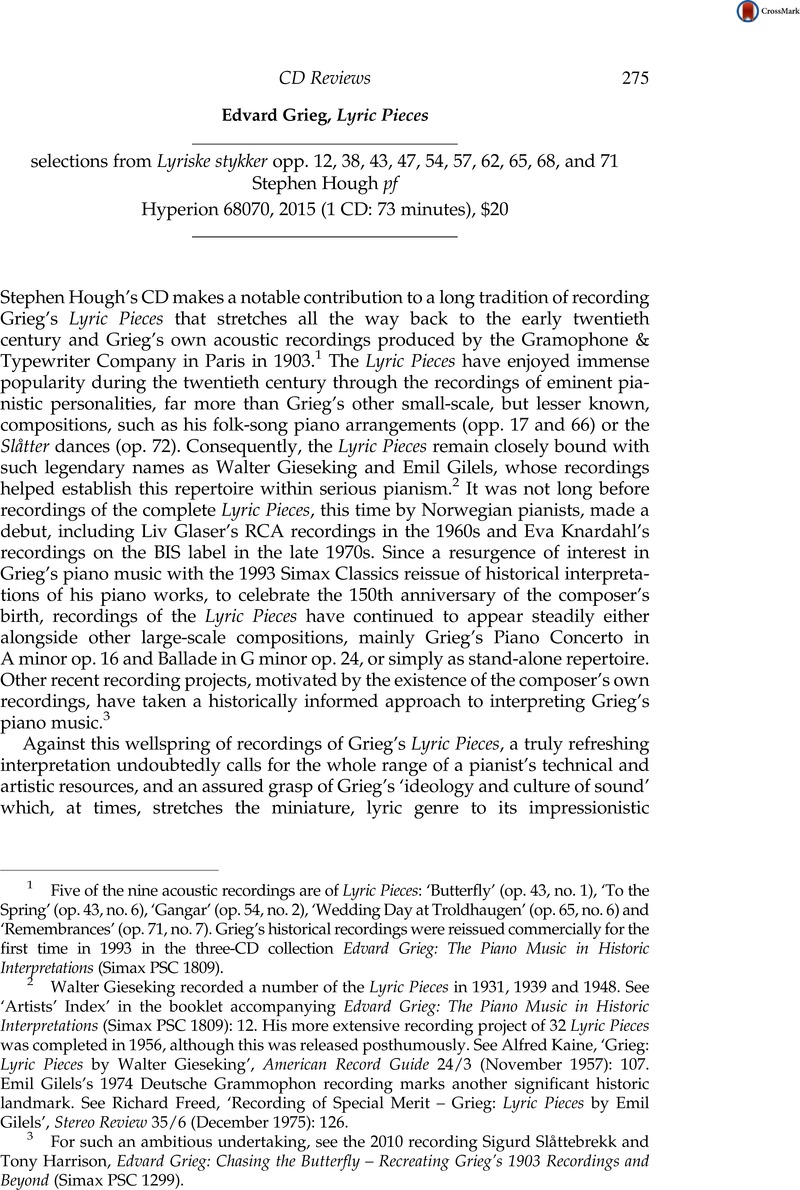No CrossRef data available.
Published online by Cambridge University Press: 01 December 2016

1 Five of the nine acoustic recordings are of Lyric Pieces: ‘Butterfly’ (op. 43, no. 1), ‘To the Spring’ (op. 43, no. 6), ‘Gangar’ (op. 54, no. 2), ‘Wedding Day at Troldhaugen’ (op. 65, no. 6) and ‘Remembrances’ (op. 71, no. 7). Grieg’s historical recordings were reissued commercially for the first time in 1993 in the three-CD collection Edvard Grieg: The Piano Music in Historic Interpretations (Simax PSC 1809).
2 Walter Gieseking recorded a number of the Lyric Pieces in 1931, 1939 and 1948. See ‘Artists’ Index’ in the booklet accompanying Edvard Grieg: The Piano Music in Historic Interpretations (Simax PSC 1809): 12. His more extensive recording project of 32 Lyric Pieces was completed in 1956, although this was released posthumously. See Kaine, Alfred, ‘Grieg: Lyric Pieces by Walter Gieseking’, American Record Guide 24/3 (November 1957): 107 Google Scholar.Emil Gilels’s 1974 Deutsche Grammophon recording marks another significant historic landmark. See Freed, Richard, ‘Recording of Special Merit – Grieg: Lyric Pieces by Emil Gilels’, Stereo Review 35/6 (December 1975): 126 Google Scholar.
3 For such an ambitious undertaking, see the 2010 recording Sigurd Slåttebrekk and Tony Harrison, Edvard Grieg: Chasing the Butterfly – Recreating Grieg’s 1903 Recordings and Beyond (Simax PSC 1299).
4 Concerning how many of Grieg’s miniatures tend to encapsulate abstract sound moods rather than pictorial imagery, see Sutcliffe, W. Dean, ‘Grieg’s Fifth: The Linguistic Battleground of “Klokkeklang”’, The Musical Quarterly 80/1 (1996): 161–181 CrossRefGoogle Scholar, and Grimley, Daniel, Grieg: Music, Landscape and Norwegian Identity (Woodbridge: Boydell, 2006)Google Scholar.
5 As Grieg himself had acknowledged, ‘We are of north-Teutonic stock, and … have … the propensity toward melancholy and brooding … [But] we have always loved brevity and succinctness, the clear and concise mode of expression … These qualities are also what we aim for in our artistic endeavours’. See Benestad, Finn and Halverson, William H., eds, Edvard Grieg: Diaries, Articles, Speeches (Columbus: Peer Gynt Press, 2001): 352 Google Scholar.